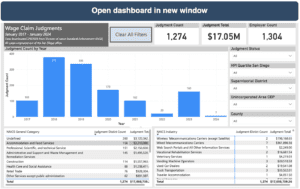Localities Up the Ante to Encourage Better Corporate Behavior
Every year, companies steal more than $1 billion in wages from workers in New York State alone. Thousands of robbed workers never see their pay, even when state regulators verify their claims and fine their employers.
In response, lawmakers are getting tough on deadbeat companies. They’re considering legislation that would suspend their liquor licenses, institute stop-work orders, and/or suspend certificates that allow companies to collect sales taxes.
New York isn’t alone when it comes to cracking down on wage-theft companies. Across the country, communities are using a combination of enforcement, education, and data to help curb the problem.
In New Jersey, officials shut down 27 Boston Market restaurants until they paid $2.5 million to 314 workers owed back wages. Companies in San Jose, Calif., are disqualified from bidding on public contracts if they have two or more wage theft violations in the past five years or one unpaid wage theft judgment.

In San Diego County, as deputy director of the first Office of Labor Standards and Enforcement (OLSE), Branden Butler is incorporating a number of strategies to help workers recover stolen wages and educate employers on wage-law compliance.
To help workers survive wage-recovery delays, Butler’s office offers workers who have won wage theft cases up to $3,000 while the county goes after the employer – which often never pay a dime.
The county has also introduced additional penalties, such as withholding permits for restaurants (an industry where wage theft is prevalent) or disqualifying companies from applying for public contracts if they have active wage theft liens against them.
To raise the floor of potential applicants getting a piece of the annual $2 billion San Diego County spends in public contracts, companies receive extra points if they pay higher wages or offer benefits.
Butler’s background has been all about getting justice for those who have little power. An attorney, he had been with the California Department of Fair Employment and Housing, the Fair Housing Center of the Legal Aid Society of San Diego, and Communities Actively Living Independent and Free, a disability housing rights organization Los Angeles.
Butler was struck by the lack of data when he arrived in San Diego: it wasn’t possible to know how many wage theft judgments had actually been paid out or even the full scope of the problem. So, he helped create the Wage Theft Judgment Dashboard.
I emailed with about the ambitious effort underway in southern California to get workers justice while encouraging companies to be part of the solution.
How does your background influence the way you think about and approach your current job?
I’m trying to have a positive impact as I see myself as a voice for the communities, the people, that have not been seen/heard. My father was a high school teacher for students with developmental disabilities and my mother was an elementary school teacher, both in public schools in Southern California that were in low-income communities where most students were Black, Asian, and Hispanic. Public service and striving for justice were ingrained from an early age by my parents. Being a Black man going through my background and life experiences has provided me a unique lens to approach issues of justice to build bridges to solutions.

Q: Tell me more about the Wage Theft Judgment Dashboard, including what motivated its creation?
A: OLSE is driven by data-based research. To define the scope of the office, we needed to have a deep knowledge of the known cases of wage theft to 1) understand the extent of the problem and 2) create policy ideas to share with the community to address the problem of wage theft. The dashboard really provides a level set of data which OLSE can use to shine a light on wage theft in San Diego County using an empirical approach which can be the basis for future policies to address wage theft.
Q: What do you hope the dashboard accomplishes, for workers and for employers?
A: To provide a real-time look at the impact and extent of wage theft, especially for workers and employers who are not familiar with the issue; to increase knowledge and awareness; and to work together to lift up the issue of wage theft. I also think the dashboard serves a public purpose by helping other governments, researchers, homeowners, and others learn about the companies they do business with.
Q: We have a database called Violation Tracker that tracks a wage range of corporate misconduct, including wage theft. We expect it will soon hit an unfortunate milestone of $1 trillion in assessed penalties. Sometimes, it can feel disheartening to watch those numbers keep spiking up. Do you ever feel despair or frustration, especially when seeing the same companies have reoccurring problems?
A: I do feel frustration because I want to dig deeper and determine what strategic tools and ideas have not been utilized yet, that could positively impact workers and the businesses that are following the rules. At the same time, there are lots of folks doing great work that is having a positive impact for workers in our communities. However, I think there is a collective acknowledgement using all the data we have collectively analyzed about wage theft over the years that prompts a discussion of new ideas/paradigms to combat wage theft.
Q: Are you seeing more communities take steps like the County of San Diego, in being pro-active on issues like employer and employee relations?
A: I think we are seeing the regionalization of labor standards occurring right now because local communities are closer to the folks being impacted and are motivated to use data driven research to create policy to address the issues raised by the community. More communities are using data on wage theft to better understand the impact it is having in their communities and are bringing innovative ideas to stop wage theft and help workers.
Read more:
5 Questions With Ike Brannon: Amazon’s Missing Economic Influence
5 Questions With Dave Wells: Tempe, Arizona Voters Reject NHL Arena Subsidy
5 Questions with Bridget Fisher: New York Penn Station’s TIF Problem
5 Questions with Jane Vancil: Auto-tracking subsidy outcomes
5 Questions With Ioana Marinescu: Low-Wage Earners Face Harsher Working Conditions
5 Questions with Tom Speaker: New York Breaks Up With Opportunity Zones
5 Questions with Joel Bakan: Ending Corporations’ Stranglehold on Society
5 Questions with Michelle Dillingham: Cincinnati’s TIF Crusader
5 questions with Patricia Todd: Alabama’s Transparency Problem
5 questions with David Wessel: Opportunity Zones, a Rich Man’s Game
5 Questions with Jonas Heese: When Newspapers Close, Corporate Misconduct Goes Up
5 Questions with Dorothy Brown: Federal loan forgiveness a good start
5 Questions with Sarah Austin: A Tax Avoidance Strategy Big Box Retailers Love
5 Questions with Joshua Jansa: Economic Development Subsidies Concentrate Wealth Upwards